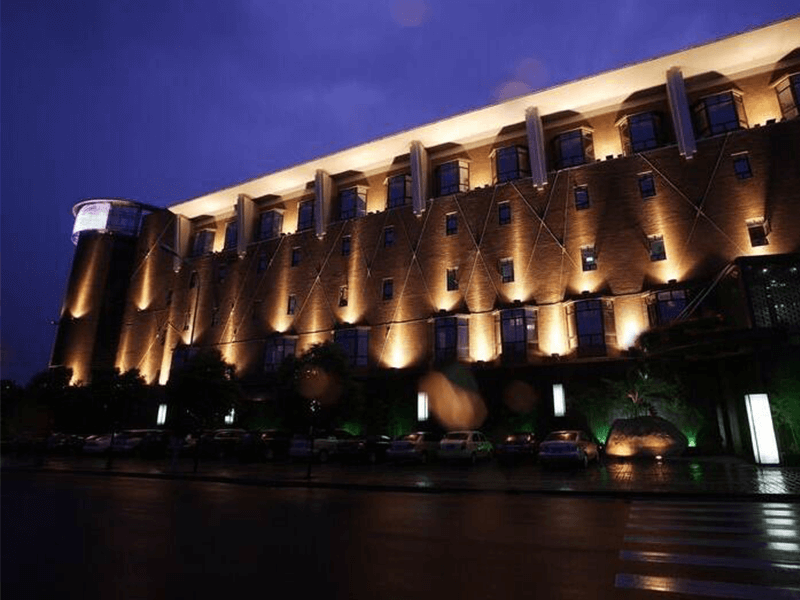Recessed downlights are fixtures installed within ceilings that emit focused light downward. They blend seamlessly with architecture, offering a clean and discreet appearance. These versatile fixtures provide ambient, task, or accent lighting in various settings. By delving into their distinctive features, applications, and pros and cons, we gain a comprehensive understanding of the role recessed downlights play in shaping interior and architectural environments.
Features:
Recessed downlights are characterized by several key features that contribute to their widespread use across various applications:
- Sleek Design: Their seamless integration within ceilings creates a clean, unobtrusive appearance, allowing other design elements to take center stage.
- Versatility: Recessed downlights are adaptable to numerous settings, including residential, commercial, and hospitality spaces. They excel in providing general illumination, task lighting, and accent lighting.
- Focused Direction: These fixtures emit light downward in a concentrated manner, directing illumination precisely where needed. This makes them ideal for task-oriented spaces like kitchens and workstations.
- Spatial Illusion: Recessed downlights can visually expand the perception of space by eliminating the visual clutter associated with protruding fixtures.
Applications:
Their discreet design, focused illumination, and adaptability contribute to their popularity across various settings. Here are some prominent applications where recessed downlights excel:
1. Residential Spaces:
In homes, recessed downlights serve as a staple lighting solution. They can be strategically placed in living rooms, kitchens, bedrooms, and bathrooms to provide ambient illumination, task lighting, or accent lighting. Recessed downlights can also be utilized in corridors and hallways to maintain a seamless visual flow.
2. Commercial Environments:
Recessed downlights find utility in commercial settings such as offices, conference rooms, and lobbies. They offer even illumination for workspaces, enhance presentation areas, and contribute to a professional ambiance.
3. Hospitality Venues:
Hotels, restaurants, and cafes employ recessed downlights to set the mood and create inviting atmospheres. These fixtures can highlight dining areas, corridors, and reception desks, enhancing the guest experience.
4. Retail Stores:
In retail spaces, recessed downlights play a pivotal role in showcasing merchandise. They can be directed towards displays, shelves, and product areas, effectively highlighting products and encouraging customer engagement.
5. Art Galleries and Museums:
The precise illumination of recessed downlights is ideal for art galleries and museums. These fixtures can be strategically positioned to spotlight artworks, sculptures, and exhibits, enhancing the visual impact and showcasing intricate details.
6. Educational Institutions:
Recessed downlights ensure well-lit classrooms and lecture halls in schools and educational facilities. They contribute to an optimal learning environment by providing comfortable lighting for students and educators.
7. Healthcare Facilities:
Recessed downlights can be used in healthcare settings, such as hospitals and clinics, to provide efficient and glare-free lighting in patient rooms, waiting areas, and corridors.
8. Entertainment Spaces:
Recessed downlights are valuable in entertainment spaces like home theaters and media rooms. Their controlled and focused illumination contributes to an immersive viewing experience.
9. Outdoor Covered Areas:
While primarily used indoors, recessed downlights can also be employed in covered outdoor areas, such as patios, porches, and covered walkways. They provide functional lighting while maintaining a cohesive design aesthetic.
Pros:
- Minimalistic Aesthetic: The recessed design seamlessly integrates into ceilings, creating a modern, clutter-free aesthetic.
- Focused Illumination: These downlights offer concentrated lighting, making them practical for tasks that require enhanced visibility.
- Ambient Lighting: When combined in groups, recessed downlights provide ample ambient lighting, creating a well-lit and comfortable environment.
- Architectural Enhancement: Recessed downlights can be strategically positioned to highlight architectural features, artworks, or decorative elements.
Cons:
- Installation Complexity: Proper installation requires creating openings in ceilings, which can be more complex and time-consuming compared to surface-mounted alternatives.
- Limited Directional Flexibility: Unlike adjustable downlights, recessed variants cannot typically change the direction of the light beam.
- Lighting Uniformity: Recessed downlights may lead to uneven lighting in spaces with high ceilings, as the light may need to reach the floor adequately.
- Heat Accumulation: Depending on the bulb type used, recessed downlights can generate heat, potentially affecting the overall temperature of a room.
